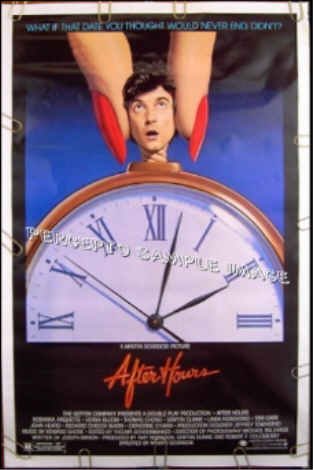
AFTER HOURS
US, 1985, 97 minutes, Colour.
Griffin Dunne, Rosanna Arquette, Verna Bloom, Thomas Chong, Cheech Marin, Linda Fiorentino, Teri Garr, John Heard, Catherine O’ Hara, Dick Miller, Will Patton, Bronson Pinchot, Victor Argo.
Directed by Martin Scorsese.
After Hours is an offbeat Martin Scorsese film. Having emerged at the end of the 1960s with small gritty films like Who’s Knocking At My Door, Scorsese made his mark in the 70s with Mean Streets, going on to Oscar nominations and acclaim with such films as Taxi Driver. This reached a peak with the acclaim for his 1980, Raging Bull. He was not so successful during the 1980s with the oddball comedy, The King of Comedy, Paul Newman in The Colour of Money and The Last Temptation of Christ. After Hours fits between The King of Comedy and The Colour of Money. During the 1990s, however, Scorsese emerged as one of the major American film-makers with such films as Casino and Age of Innocence. He continued to be Oscar-nominated with such films as Gangs of New York and The Aviator.
This is a film about urban paranoia amongst yuppies. Griffin Dunne is a word-processing expert who suffers a strange series of misadventures during one night. He is trying to meet women but is shy. He meets a friend in a restaurant and goes to visit her sculptress friend – which leads to misunderstandings, fights, murder or suicide, his losing all his money, his finding places closed when he thought they would be open, strange taxi rides, being enclosed in a plaster and being stolen as if he were a sculpture.
The film has a strong supporting cast led by Rosanna Arquette and Linda Fiorentino as the sculptor. Cheech and Chong appear as thieves.
1.The appeal of the film? Critical acclaim?
2.The work of Martin Scorsese up to this point? Urban themes? Style, creation of paranoia in New York?
3.A New York story (could it have been set elsewhere)? New York at night, the range of people, the office, the bar, the art world, bohemian characters, thieves, gay people, the clubs, waitresses, vigilantes? A gallery of New Yorkers for observation, identifying with, humour, menace?
4.New York and the uptown neighbourhoods? The workplaces, apartments, cafes? The contrast with downtown and the lofts, the streets, the rain? Bars, clubs and cellars? Light and dark? Sinister? The contrast between office work and the work of bohemian artists?
5.The title and its reference to a night in the experience of Paul? At the office – the range of word processors (and the personal greeting from his own)? The office gate at the start and at the end? Paul’s nightmare?
6.The strong cast, presence and style? The musical score, ‘Someone to Watch Over Me’, Peggy Lee and ‘Is That All There Is’, Joni Mitchell? Contemporary songs? The world of art and audience response to the songs? Audience response to visual art? The film as a visual happening?
7.Paul’s story: by the end, summing it up? Frantic? An impossible story yet his retracing it? An ordinary man, at work in the office, word processors? Instructions? His wanting to become the new man, his dream? Leaving the office, wanting to go home, being alone? The meeting with Marcy and the discussion? The cashier and ambitions? Dance? The phone number, the beagle? The ring and the zany aspects? His leaving, in the taxi, the losing of the twenty-dollar bill, the later reappearances of the money? Its later being taken? The speed? Marcy taking him to see Kiki? The keys? Her work? Munch and The Scream? Help, his shirt? The massage and the story? The bra, being tied up? At the bar – the beagle? Marcy and her erratic interactions with him, the tablets, the shower? Greg and the joint? The argument, his listening, going out (and the Dick Miller cameo)? His leaving – and her death? The effect, ring? “Dead person”? His fear, looking and taking cover? The effect on him? The subway? Going to the bar, the encounter with Tom, getting the keys? His friendliness, the money? The gays, the burglar? Julie and her note? The meeting, the apartment? The 60s and The Monkees? His erratic behaviour? The drawing of the notices? Tom and his relationship with Marcy? The bar and the hamburger? The gay man and the story? The pursuit by the posse? Cheech and Chong as the robbers, taking the statue with him in it? Gail and her phone call, the leading of the attack? Hiding, the chase, the clubs, the Club Berlin, almost getting the mohawk? Hiding and June’s help? Being stolen, the statue being broken open? His escape?
8.Marcy and her needs, the discussions, the phone call, the loft, her husband? Giggling, the shower? Listening? Her being upset, her death? The relationship with Tom? The effect on Paul?
9.Tom as a pleasant man, lending the money, Julie? Giving the keys? His relationship with Marcy?
10.Julie and her job, home, taste, the drawing, pursuit?
11.Gail and her help, the taxi, the wound? The truck and the chase?
12.June and the drink, hiding? The statue?
13.Cheech and Chong, their film background, stoned comics? The robbers?
14.The gay man, the pick-up, the phone and the story?
15.Kiki and her art, the massage, her boyfriend, the club?
16.The club owners, the hamburger places?
17.Paul’s nightmare, his innate orderliness and its being disturbed? A tiring night? His hopes – and returning to the start?